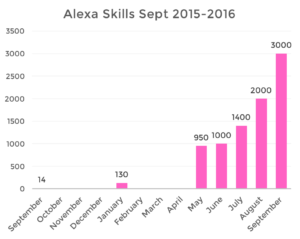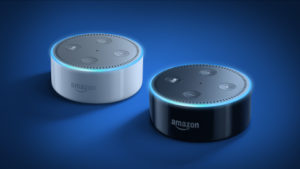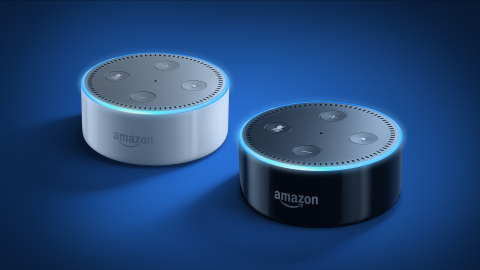Amazon Alexa Gains Momentum with Brands, Consumers, Partners and International Launch
 Amazon’s Alexa has had a good week and recent events are signaling more growth for the voice web. Amazon reported Tuesday that there are now more than 3,000 skills for Alexa. That is up from 1,000 in June, 135 in January and just 14 one year ago. In the past week, Food Network, GE Appliances, Liberty Mutual all announced skills which many people think of as apps for Alexa. These announcements are significant news, but Amazon was just getting started.
Amazon’s Alexa has had a good week and recent events are signaling more growth for the voice web. Amazon reported Tuesday that there are now more than 3,000 skills for Alexa. That is up from 1,000 in June, 135 in January and just 14 one year ago. In the past week, Food Network, GE Appliances, Liberty Mutual all announced skills which many people think of as apps for Alexa. These announcements are significant news, but Amazon was just getting started.
Consumers can now have their very own Alexa device for under $50. The Echo Dot is a smaller version of the original Amazon Echo. Sold out since July, you can now pre-order a Dot for October shipment for just $49.99. Google Home and other contenders for voice web devices have a new target to meet. Also this week, Orion Labs released a personal walkie-talkie device that will have Alexa access next month. Almost lost in all of this news, Amazon announced that the Echo and Dot are now available for pre-order in the UK and Germany.
Critical Factors Behind Technology Adoption
I wrote in the Huffington Post last month that Alexa represents the first mass-market manifestation of the voice web and it has many similarities to the growth of the world wide web – the visual web – in the 1990’s. There were many factors behind the growth of the visual web, but four circumstances were particularly critical for laying the foundation for early success.
- Rapid Growth of Content
- Falling Cost of Devices
- Availability of Free Browsers
- Global Accessibility
Rapid Growth of Voice Web Content – The Skill Explosion
The visual web was interesting in 1994, but it became even more useful each year as individuals, companies and media publishers created websites with new content. Each additional website created more value for web users and expanded the appeal to a wider audience. We saw this phenomenon play out again in the growth of smartphones pioneered by the iPhone App Store. The more apps, the more utility for users, the more desirable the smartphone. The voice web is getting this content infusion with the rapid growth in Alexa skills.
Falling Device Cost – Spurring Consumer Demand
 The role of pricing in generating demand works. In the early 1990’s computer prices started to fall below $2,000. This made them more accessible to mass market consumers and 24 million had home PCs by 1995. By 1996, you could even buy a laptop for under $1,500 and prices continued to fall making a computer more accessible to more households each year. The Amazon Echo debuted at $179 and now the smaller Echo Dot is offered at $49. You can now access the voice web for the price of 12 Venti Lattes at Starbucks. The lower price will entice more consumers to try the voice web and understand why the Echo has become so popular. Siri may have introduced the masses to voice assistants, but the Echo Dot will be how many people first experience the voice web and the tremendous utility of voice-first computing in many circumstances. I have used both the Echo and Echo Dot and there is a difference in sound quality. However, if you have only experienced the Dot, you probably won’t notice that you are missing anything. If you want better sound quality, there are a lot of Bluetooth speakers out there or the pricier Echo tower.
The role of pricing in generating demand works. In the early 1990’s computer prices started to fall below $2,000. This made them more accessible to mass market consumers and 24 million had home PCs by 1995. By 1996, you could even buy a laptop for under $1,500 and prices continued to fall making a computer more accessible to more households each year. The Amazon Echo debuted at $179 and now the smaller Echo Dot is offered at $49. You can now access the voice web for the price of 12 Venti Lattes at Starbucks. The lower price will entice more consumers to try the voice web and understand why the Echo has become so popular. Siri may have introduced the masses to voice assistants, but the Echo Dot will be how many people first experience the voice web and the tremendous utility of voice-first computing in many circumstances. I have used both the Echo and Echo Dot and there is a difference in sound quality. However, if you have only experienced the Dot, you probably won’t notice that you are missing anything. If you want better sound quality, there are a lot of Bluetooth speakers out there or the pricier Echo tower.
Availability of Free Browsers – Ubiquitous Access
The introduction of the free Mosaic and Netscape browsers were critical to the growth of the visual web. If there had been a cost to purchase browsers many people would have delayed adoption. Because they were free, visual web access quickly became ubiquitous for all computer users with many manufacturers even pre-installing browsers. We see a similar trend today with devices ranging from walkie-talkie style communicators and Bluetooth speakers to cars from Hyundai and Ford adding Alexa Voice Service to their products. People already have access to voice assistants on smartphones. They now increasingly have them in the other devices that few would have considered smart a year ago.
Global Accessibility – A Shared and Common Experience
Finally, the visual web connected the globe. You could create content in one place and have it accessible everywhere at once. The availability of Alexa the UK and Germany is a step in that direction for Amazon and opens up access to a entirely new set of developers and companies that can become content suppliers.
Seeing the Voice Web Trend in Real Time
Mary Meeker of KPCB commented at Code Conference 2016 in June that, “inflection points are typically only obvious in hindsight. So ask the question – iPhone sales may have peaked in 2015…while Amazon Echo sales are just beginning to take off. Food for thought.” Over the past three months the trend lines have become even more clear. Gartner predicted last year that, “by 2018, 30% of our interactions with technology will be through “conversations” with smart machines.” That prediction just might be right and this past week we saw more evidence of the trend accelerating.









